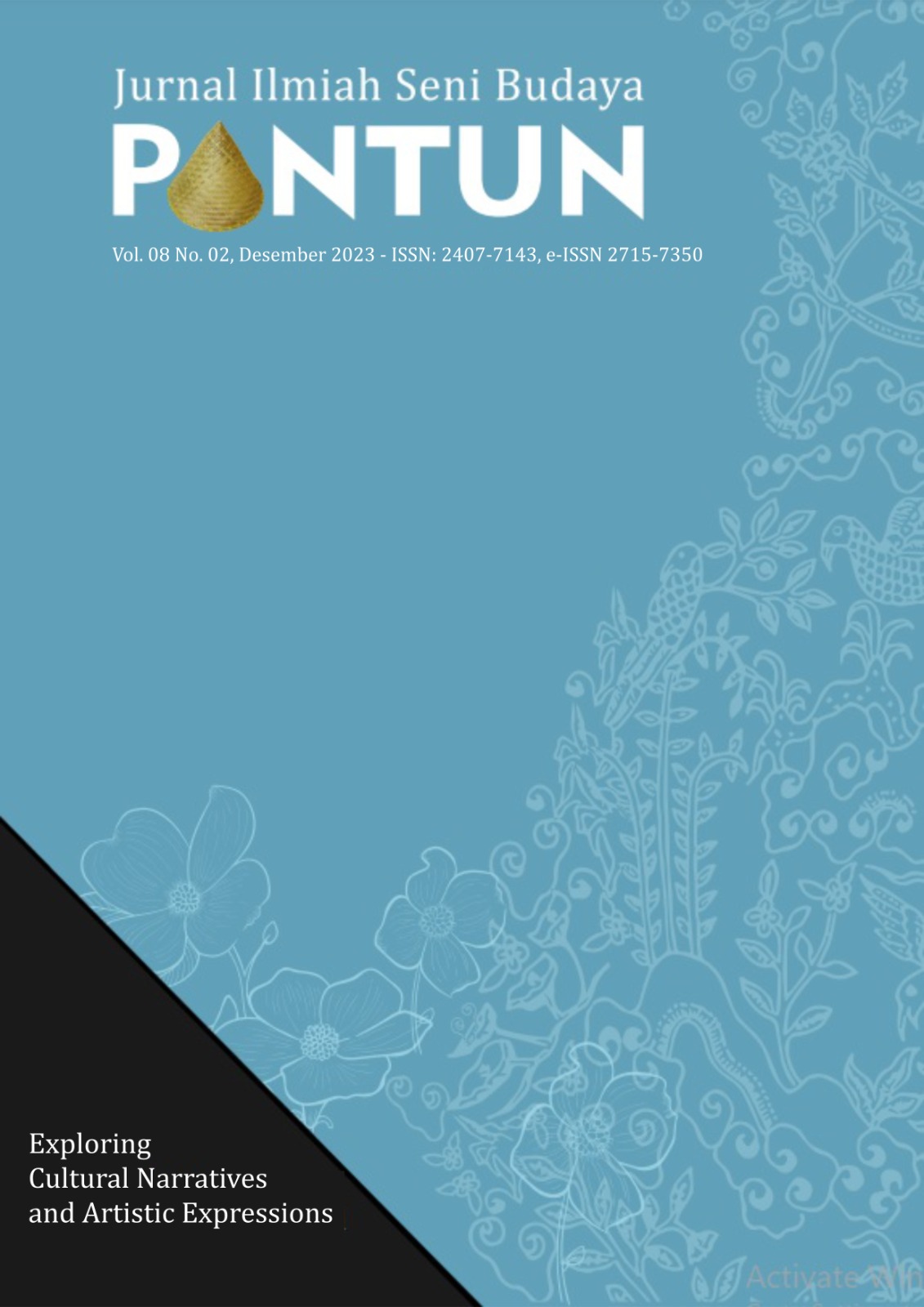The Construction of Sign that form Kabuyutan Cibulan
DOI:
https://doi.org/10.26742/pantun.v8i2.2797Kata Kunci:
kabuyutan, cibulan, sign, river, tritangtu.Abstrak
Referensi
Arikunto, S. 2002. Metodologi Penelitian Suatu Pendekatan Proposal. Jakarta: PT. Rineka Cipta.
Alviya, I. (2006). Penetapan Hutan Lindung Gunung Ceremai Menjadi Taman Nasional Dan Dampaknya Bagi Masyarakat Sekitar Kawasan. Jurnal Analisis Kebijakan Kehutanan Vol. 3 No. 2, Juli 2006 : 87 – 94
Djuniarti. & Dwimarwati, R. (2017). Cosmos Matrimony Between Kebo Wulan And Pwah Apsari Jabung On Kawin Cai. E-Prosiding Pascasarjana ISBI Bandung, Proceedings International Conference On Arts & Culture, Vol 1, No 1 (2017).
Djuniarti. (2017). Sakralitas Air Dalam Upacara Kawin Cai Di Kuningan. Pascasarjana ISBI Bandung, Bandung.
Eliade, M. (2002). Sakral dan Profan. Yogyakarta: Fajar Pustaka Baru.
Preasetyo, E, B., Heriyawati, Y., & Saleh, S. (2022). Struktur Tanda Pembentuk Sakralitas Sumur 7 Objek Wisata Cibulan. Pantun Jurnal Ilmiah Seni Budaya, Vol. 7 No. 1.
Koentjaraningrat. (1977). Metode-Metode Penelitian Masyarakat. Jakarta: P.T Gramedia.
Noerdjito, M., Royyani, M, F., & Widodo, H. (2009). Peran Adat dan Pensakralan Mata Air Terhadap Konservasi Air di Lereng Ciremai. Jurnal Biologi Indonesia, 5(3): 363- 376.
Pratiwi, M, K, G. (2017). Mitos-Mitos Di Gunung Lawu: Analisis Struktur, Nilai Budaya, dan Kepercayaan. Surabaya: Universitas Negeri Surabaya.
Sumardjo, J. (2019). Struktur Filosofis Artefak Sunda. Bandung: Kelir.
Sumardjo, J. (2014). Estetika Paradoks. Bandung: Kelir.
Sumardjo, J. (2015). Sunda Polarasionalitas Budaya. Kabupaten Bandung : Kelir.
Sugiyono. 2007. Metode Penelitian Kuantitatif Kualitatif dan R&D. Bandung: Alfabeta.
Tambunan, J, B., Hutauruk, S., & Pardede, Z, H, S, (2017). Mitos Tradisi Perayaan Tahun Baru Imlek. Pantun Jurnal Ilmiah Seni Budaya Vol. 2 No. 2 Desember 2017
Yulifiar, L. (2018). Kabuyutan Cipageran Cimahi Dari Zaman Ke Zaman Kabuyutan Cipageran Cimahi From Time To Time. Patanjala Vol. 10 No. 3 September 2018: 471 – 486.
Unduhan
Diterbitkan
Terbitan
Bagian
Citation Check
Lisensi
The Authors submitting a manuscript do so on the understanding that if accepted for publication, copyright of the article shall be assigned to Pantun: Jurnal Ilmiah Seni Budaya and Pascasarjana ISBI Bandung as the publisher of the journal. Copyright encompasses rights to reproduce and deliver the article in all form and media, including reprints, photographs, microfilms, and any other similar reproductions, as well as translations.
Pantun: Jurnal Ilmiah Seni Budaya and Pascasarjana ISBI Bandung and the Editors make every effort to ensure that no wrong or misleading data, opinions or statements be published in the journal. In any way, the contents of the articles and advertisements published in Pantun: Jurnal Ilmiah Seni Budaya are the sole and exclusive responsibility of their respective authors and advertisers.
The Copyright Transfer Form can be downloaded here: [……………..) The copyright form should be signed originally and send to the Editorial Office in the form of original mail, scanned document or fax :
Dr. Jaeni, S.Sn., M.Si. (Editor-in-Chief)
Editorial Office of Jurnal Pantun
Program Pascasarjana ISBI Bandung
Jl. Buah Batu 212 Bandung
Telp./fax +62-22-730532/+62-22-7303021
Email : jurnalpantun@isbi.ac.id











